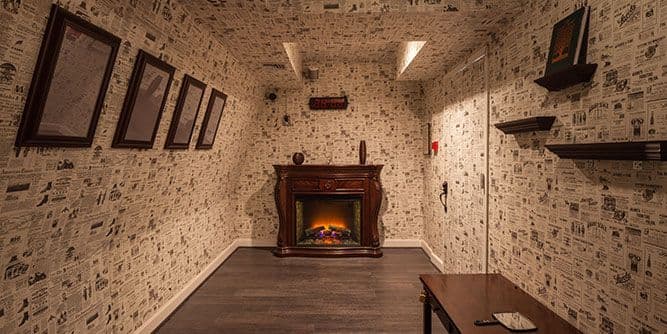7 Steps for Writing Escape Room Narratives (And How to Find Opportunities to Write Them)

7 Steps for Writing Escape Room Narratives (And How to Find Opportunities to Write Them)

A screenwriter walks into an Escape Room…
But seriously… this is not a joke. It’s an opportunity to hone your skills as a writer and get in on one of the fastest growing entertainment industries around.
A few years ago I was hired to write narratives for two new Escape Rooms. The organization had been successful at tourist-based entertainment programs for nearly two decades, and was looking to capitalize on the growing phenomenon that is the 60-minute Escape Room.

As a writer on the lookout for new and exciting opportunities to tell stories, you should be familiar with this wildly popular and always evolving pastime. In less than a decade, Escape Rooms have gone from players solving a series of puzzles in an hour or less to get out of a locked room, to Escape Room 2.0*:* Puzzles with action-driven story lines and complex characters that are both digitally integrated and played by on-site actors.
Always eager to write for new media, I set about some research. Here’s what I found:
Only a decade old, there are more than 8,000 Escape Rooms in the world. Almost a third of them are in the United States. With some 2.0 Escape Rooms boasting million-dollar budgets and Escape Room aficionados now having played well over 100 rooms in their quest for the best, the stakes are high and the field more competitive.
Enter the writer, whose skills are just what these companies need to keep a 5-Star and ticket sales strong.
Story is story, by and large. Action is character and structure is fundamental. Show, don’t tell. So what makes writing for Escape Rooms the unique challenge that it is?
Glad you asked.

The emphasis is on puzzles. The writer must ask themselves:
- How do the puzzles fit into the story?
- How can I tell a story that is deep, but not wide, because of the one-hour time frame?
- Am I willing to write a story that delivers plot points in easily digestible bits that continually drive the action?
Solving these challenges not only makes for a 5-Star Escape Room experience, it makes you a better writer when it comes to mapping plot points and creating complex characters.
It’s all about seamless integration of character, story, and puzzle. I bet that sounds at least a little familiar. So let’s break it down.

1) Integrate Time Goals With the Narrative
Honoring the Escape Room 2.0 mantra of “total immersion,” it’s important to integrate the time factor in the narrative. Almost all Escape Rooms have a one-hour time limit, so that’s the place to start. What story can you tell that culminates in the players reaching their objective in a hour?
For a gumshoe noir I wrote, I employed the “ticking time bomb” that drives hundreds of classic thrillers. If the players don’t solve all of the puzzles in an hour, the bomb detonates, killing several hostages.
For a pirate adventure, I created high-stakes circumstances where the pirates defending a fort have only an hour’s worth of powder and shot. After that, they’ll be mercilessly slaughtered while the Royal Navy seizes a hidden object that is the players’ primary target. Any kind of time-sensitive crisis will do. A compartment flooding, the full moon rising and unleashing monsters, may be even having one of the players ingesting a poison that takes 60 minutes to take effect. Make it mean something (raise the stakes), and the players will be hooked.

2) Create a Clean Narrative That Drives the Action Toward the Goals
Escape Room players are hyper-focused on achieving the goal of escaping the room, finding a key artifact, or solving a mystery/completing a required final action. So your storyline must be simple enough that this goal does not get lost in a mess of confusing narrative.
Don’t use subplots or unnecessary characters. Again go deep but not wide. Although some Escape Rooms use dead ends or puzzles intended to mislead, don’t rely on tricks. A clean, clear story adds to the tension, excitement, and immersion, delivering the plot points in easily digestible beats that drive the action and players toward their goal.

3) Create “Hooks” to Hang the Puzzles
Ideally, the puzzles and stories are developed together. They are initial meetings centered on a genre or theme that allows the narrative “hooks” (plot points tying directly to a puzzle or puzzles) to organically emerge.
In the Escape Rooms I work on, give-and-take is essential. I love it when the designers come to me with a puzzle they just have to use, challenging me with how to incorporate it in the developing narrative. Strong plot points full of emotional possibilities will also suggest the types of puzzles that best suit the situation, especially for veteran designers with the goal of creating something new.
Working back and forth with puzzle designers is ideal, but some of them are purists who want it to be all about the puzzles. Sometimes the game designer has puzzles already made that were left over from previous rooms or purchased on clearance, and it’s your job to design a story around them.
If the puzzles are already decided, study them closely, asking yourself:
- How do they work?
- What situations do they inspire?
- How can your story make the puzzles more fun, important, and challenging?
- What mysteries can solving these puzzles illuminate?
The answers will indicate just where your hooks should be.

4) Immerse the Players in the Narrative
Find as many ways as you can to immerse the players in the story beyond solving the puzzles and either escaping the room or accomplishing another goal.
The best way to do this is through character. Non-player characters (NPCs) are your best asset. If the narrative for has the budget for at least one, take advantage of it. Ideally, once check-in and housekeeping are complete, the NPC should take lead for the players’ experience prior to, during (delivering clues as a game-master does), and after the game. This allows for an immersive and inviting (or foreboding, depending on the genre) theatrical experience.
With a strong NPC, a little imagination, and a genre-matching waiting room, players are immersed before they ever start the game.
If there isn’t a budget for NPCs but you want your players invested in the outcome beyond the bragging rights that come with the winners’ photo on social media, incorporate complex, compelling characters. Have those complex characters communicate their wants and needs through the puzzles and any audio or written messages integrated into the experience.
In the gumshoe noir, the players unlock audio and written messages from the missing gumshoe that they are helping to solve the case. His encouragement and requests for help drive the players on.
In that same room, the antagonist, a “madman” who planted a bomb on a ship where he keeps three youths hostage, also communicates with the players. The madman relates his story of past betrayal and the unjust death of his son through a phone call, scribblings on the walls, and various letters and documents the players find as they play.
Creating a complex antagonist gave us an opportunity to be innovative and create three different endings. The players can:
(1) Help the antagonist by detonating the bomb.
(2) Dismantle the bomb but allow him to escape.
(3) Dismantle the bomb and have him arrested.

5) Set Up Circumstances That Produce Emotions
As with all good storytelling, you want to write for lots of emotional notes. Even an R-rated adult horror room with lots of jump scares and splatter opportunities shouldn’t be just scary. Building complexity into the characters is the surest way to evoke empathy.
But be cautious. Pitting players against one another or providing poor clues or misinformation in order to make them jealous or frustrated makes for a lousy experience and worse reviews.
Create plot points that vary the mood and set up moral dilemmas or other decision points for the players outside their primary goal. For example, evoking sympathy for the madman in the third act of the game as the detonator is winding up and heart-pounding music is pumping through the sound system, is the kind of experience that stays with players long after they leave.

6) Integrate Historic and Geographic Context
My experience with writing narratives for Escape Rooms has been in a tourist area with a rich maritime history where geography informs narrative. Knowing the area and history very well, I used that to my advantage in my pitch.
The Golden Age of Piracy, a narrative I wrote, stars the infamous Blackbeard who was active in the area where the Escape Room was built.
The gumshoe noir centers on the U-boat attacks on the Outer Banks of North Carolina during World War II.
Historical tourism is at an all-time high, so this is a top-shelf marketing strategy. We get players that wouldn’t normally try an Escape Room just so they can learn more about the area. Historic and geographic context also provides a doorway to deep immersion and a unified and life-like production. Given the popularity of period films and television series, this is an invaluable skill for you to have.

7) How to Get Hired to Write for Escape Rooms
If you haven’t written for escape rooms before but you think you’d like to, there are opportunities around you that you might not be aware of. Here’s what I recommend if you want to get hired to write for Escape Rooms:
- First, find Escape Rooms in your area. With over 8,000 up and running, and more opening every day, there should be at least one nearby.
- Before you enter, do a little research on the area so you can start developing pitch ideas connected to local and regional history.
- Play their Rooms, keeping in mind the seven steps above. What are they doing well? What do they lack? How can you give them something they don’t already have?
- After you play, talk with the manager. Some rooms are designed in-house and others are created by large companies and sold as packages. If it’s the former, set up a meeting and make your pitch as you would for any writing project. If it’s the latter, get the name of the company and do some research on what they already offer and send them a pitch with their next great idea.
Writing Escape Room narratives will not only improve your own screenwriting skills, but will also give you a unique writing edge for your portfolio.
Now, as we were saying in the beginning: A screenwriter walks into an Escape Room…

Joey Media spent 25 years in the theatre as a playwright, actor, director, and teacher.
Today is is focused on screenwriting, developing an audio drama series,
writing story lines for immersive theatre-based Escape Rooms, and creating Historical
Education programming with a focus on the Golden Age of Piracy and the life of Che Guevara.
Joey is the Artistic Director of Seven Stories Theatre Company and Creative director of
New Mystics Enterprises, a multimedia production company. He is also the author of two
novels and 17 produced plays.
Like this blog post? Please share it on social media (Facebook, Twitter, LinkedIn, email etc) by using social media buttons at the top of the blog. Or post to your personal blog and anywhere else you feel appropriate. Thank you.
As always, we welcome thoughts and remarks on ANY of the content above in the Comments section below...
About the Author

Joey Madia
Screenwriter, Director, Actor, Story Analyst, Author, Acting Teacher, Performance Coach
Joey Madia is an actor, screenwriter, playwright, Escape Room designer, podcaster, novelist, and director. He has appeared in, directed, and written well over 100 plays and a dozen projects on camera, including the 2014 remake of White Zombie and his first film as writer/director received an Hon...
More in Advice
Browse all6 Comments on Joey's Article


















